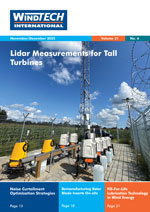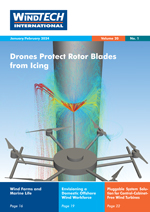The Front CoverThe research project Temporary Coating by Means of Drones – Icing Protection of Wind Turbines as a Case Study was carried out by Fraunhofer IFAM and IPA (page 6). The project involved 19 companies. The aim of the project was to provide the material technology basis for a temporary anti-ice coating and a drone-compatible application. The cover image shows a simulation of coating using a drone under the influence of wind. (source: Fraunhofer IPA) Publisher's NoteAdvances and challenges in Europe’s offshore wind energy sectorFeaturesDrones Protect Rotor Blades from Icing
By Andreas Stake and Oliver Tiedje, Fraunhofer, Germany By Frank Thomsen, Lars O. Mortensen, Naomi A.M. Tuhuteru, Jonas B. Mortensen, DHI, Denmark
By Nick Zenkin, Lead Offshore Wind Consultant, Xodus Group, USA By Andreas Franke, Business Manager Wind Energy, Beckhoff Automation, Germany
Windtech FutureIs Using DFIG in Wind Turbines an Obsolete Technology?By Ahmad Hemami, McGill University, Montreal, Canada View from InsideBy Shovana Talukdar, Senior Consultant, BVG Associates Latest News
|
|
||||||||||||||||||||














